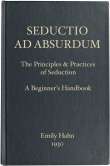قراءة كتاب Seductio Ad Absurdum The Principles & Practices of Seduction, A Beginner's Handbook
تنويه: تعرض هنا نبذة من اول ١٠ صفحات فقط من الكتاب الالكتروني، لقراءة الكتاب كاملا اضغط على الزر “اشتر الآن"

Seductio Ad Absurdum The Principles & Practices of Seduction, A Beginner's Handbook
SEDUCTIO AD ABSURDUM
(“Now I lay me—”
OLD PRAYER)
In preparation
THE SEDUCER’S VENI MECUM
A COURSE FOR ADVANCED STUDENTS
SEDUCTIO AD ABSURDUM
The Principles & Practices
of Seduction
A Beginner’s Handbook
by Emily Hahn
1930
New York
BREWER AND WARREN INC.
PAYSON & CLARKE LTD.
COPYRIGHT, 1930, BY EMILY HAHN
First Printing before Publication March 1930
Second Printing before Publication March 1930
SET UP, ELECTROTYPED, PRINTED AND BOUND
IN THE UNITED STATES OF AMERICA
BY H. WOLFF ESTATE, NEW YORK, N. Y.
DEDICATED TO
HERBERT ASBURY
WHO TOLD ME TO WRITE IT DOWN
INTRODUCTION
Although seduction as an applied art has been slowly developing over a period of several generations, the science of seduction has so far been largely neglected. While the value of the empirical knowledge acquired by early practitioners and transmitted to us by a great body of folk-lore should not be minimized, the trial and error methods of these precursors, both amateur and professional, are to be deplored as crude; for however refined they may have been in application, there is evidence that they were lacking in that exactness in observation which could make them valuable to science.
Only a very few though hardy pioneers have in the past, recognized the necessity for organizing man’s empirical knowledge of this vast subject on a rational basis, and it is due to their unselfish labours alone that we now have a sufficient body of observed phenomena, a sufficient accumulation of data, to make possible the beginnings of a true science of seduction. It is the purpose of this book, to co-ordinate the efforts of these for the most part anonymous and forgotten contributors, these modest, silent benefactors, and to attempt a proper classification within the subject: to adumbrate such practical methods of procedure as may in the, let us hope, near future develop into a sure technique. Owing to the limitations of space and the present confused state of the subject, it is of necessity only possible here to indicate the lines which such a development must follow. It is my desire to confine this work to a purely practical consideration of the subject, and to make it a handbook in the hope that my students and those who come after me will be the better able to add to the body of our observed knowledge of seduction and to indicate the more clearly for my shortcomings along what lines improvement is required.
WHAT IS SEDUCTION?
In the first place, the word itself is unfortunately obscure, possessing an ambiguity which we must resolve before we can proceed. I have assembled an assortment of representative definitions, which follows:
Se-duce (se-dus) v.t.; SE-DUCED (se-dust); SE-DUCING (-dusing). [L. seducere, seductum; se-aside—ducere to lead. See DUKE.] I. To lead aside or astray, esp. from the path of rectitude or duty; to entice to evil; to corrupt.
“For me, the gold of France did not seduce.”
—Shakespeare
—Webster’s New International Dictionary
Seduce, v.t. Lead astray, tempt into sin or crime, corrupt; persuade (woman) into surrender of chastity, debauch.
—Concise Oxford Dictionary
Seduire: v.a. (du lat. seducere, conduire à l’écart. Se conj. comme conduire). Faire tomber en erreur ou en faute par ses insinuations, ses exemples.
—Larousse
Seduccion: Acciôn y effecto de seducir.
Seducfr: Engañar con are y maña, persuadir suavemente al mal.
—Enciclopedia Universal Illustrada.
Sedurre (Seduzione, n) Ridurre con vane o false apparenze al nostre valere e al male.
—Dizionario Universale delta Lingua Italiana. Petrocchi
Verfiihrung; in geschlechtlicher Beziehung ein Mädchen verführen.
—Deutsches Wörterbuch ... Heynes
It is obvious that these interpretations all suffer from a common fault: they fail to reflect the modern ramifications of the word. As a matter of fact, seduction is undergoing a great change.
The rudiments of the custom may be observed in the remnants of primitive society that we are able to study. Certain aboriginal tribes practise polyandry as an economic adjustment to the surplus of males.[1] With the development of civilization we find that adaptation tends to take the form of matriarchy, as in the United States.[2]
In the early days of our culture, seduction was practised upon certain species of recognized placer in the social system, and thus attained a certain grade of standardization. There were the seduced (always the feminine sex) and the seducers (masculine). It would appear that with the aforementioned rise of matriarchy this state of affairs is changing. The predatory instinct of humanity is not confined to the male. However, the line of reasoning suggested is too vast to follow in the limits of a small volume, and I mention it merely that the student may think about it at his leisure as he peruses the forthcoming chapters.
The extraordinary development of prostitution in the nineteenth century prefaced the present phase with a last manifestation of the old social attitude. Relying upon the assumption that the male seduces the female, we are faced in this modern world with the undeniable fact that the ranks of the seduced—i.e., the unprotected young women of society—are also shifting and changing. The orderly arrangement which we have been led to expect is breaking up. In former times our women were divided into two main classes, or groups:
(a) Professionals (those who made a vocation of being seduced)[3]
(b)


